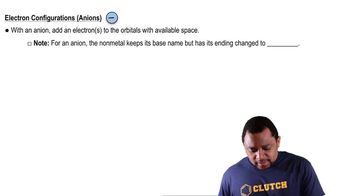Using the molecular orbital energy ordering for second-row homonuclear diatomic molecules in which the π2p orbitals lie at higher energy than the σ2p, draw MO energy diagrams and predict the bond order in a molecule or ion with each number of total valence electrons. Will the molecule or ion be diamagnetic or paramagnetic? c. 13
Ch.11 - Chemical Bonding II: Molecular Shapes, VSEPR & MO Theory

All textbooks Tro 5th Edition
Tro 5th Edition Ch.11 - Chemical Bonding II: Molecular Shapes, VSEPR & MO Theory
Ch.11 - Chemical Bonding II: Molecular Shapes, VSEPR & MO Theory Problem 78
Problem 78
 Tro 5th Edition
Tro 5th Edition Ch.11 - Chemical Bonding II: Molecular Shapes, VSEPR & MO Theory
Ch.11 - Chemical Bonding II: Molecular Shapes, VSEPR & MO Theory Problem 78
Problem 78Chapter 11, Problem 78
Apply molecular orbital theory to predict if each molecule or ion exists in a relatively stable form. a. C22+ b. Li2 c. Be22+ d. Li22-
 Verified step by step guidance
Verified step by step guidance1
Identify the total number of electrons in each molecule or ion. For example, C2^2+ has two carbon atoms (each with 6 electrons) minus 2 electrons due to the charge, giving a total of 10 electrons.
Draw the molecular orbital (MO) diagram for each molecule or ion. Start by arranging the atomic orbitals (s and p orbitals) and then combine them to form bonding and antibonding molecular orbitals.
Fill the molecular orbitals with the total number of electrons calculated in step 1, following Hund's rule and the Pauli exclusion principle. Electrons fill the lowest energy orbitals first.
Determine the bond order for each molecule or ion using the formula: Bond Order = (Number of electrons in bonding orbitals - Number of electrons in antibonding orbitals) / 2.
Assess the stability of each molecule or ion based on the bond order. A positive bond order suggests a stable molecule, whereas a bond order of zero or negative indicates instability.

Verified video answer for a similar problem:
This video solution was recommended by our tutors as helpful for the problem above.
Video duration:
8mWas this helpful?
Key Concepts
Here are the essential concepts you must grasp in order to answer the question correctly.
Molecular Orbital Theory
Molecular Orbital Theory (MOT) describes the behavior of electrons in molecules by combining atomic orbitals to form molecular orbitals. These orbitals can be bonding, antibonding, or non-bonding, and the distribution of electrons among them determines the stability and properties of the molecule. Understanding MOT is crucial for predicting the existence and stability of molecules and ions.
Recommended video:
Guided course

Molecular Orbital Theory
Bond Order
Bond order is a measure of the number of chemical bonds between a pair of atoms, calculated as the difference between the number of bonding and antibonding electrons divided by two. A higher bond order indicates a more stable molecule, while a bond order of zero suggests that the molecule is unstable and unlikely to exist. Evaluating bond order helps in assessing the stability of the given species.
Recommended video:
Guided course

Average Bond Order
Electron Configuration in Ions
The electron configuration of ions is essential for understanding their stability. When atoms gain or lose electrons to form ions, their electron configurations change, affecting their molecular orbital filling. For example, cations have fewer electrons, which can lead to higher bond orders, while anions have additional electrons, potentially lowering stability. Analyzing the electron configurations of the given ions is key to predicting their stability.
Recommended video:
Guided course

Anion Electron Configuration
Related Practice
Textbook Question
Textbook Question
Using the molecular orbital energy ordering for second-row homonuclear diatomic molecules in which the π2p orbitals lie at higher energy than the σ2p, draw MO energy diagrams and predict the bond order in a molecule or ion with each number of total valence electrons. Will the molecule or ion be diamagnetic or paramagnetic? d. 14
Textbook Question
Use molecular orbital theory to predict if each molecule or ion exists in a relatively stable form. a. H22- b. Ne2 c. He22+ d. F22-
Textbook Question
According to MO theory, which molecule or ion has the highest bond order? O2, O2- , O22-
Textbook Question
According to MO theory, which molecule or ion has the highest bond energy? O2, O2- , O22-
Textbook Question
According to MO theory, which molecule or ion has the shortest bond length? O2, O2- , O22-
1
views